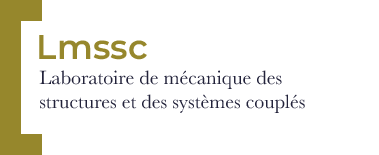A wave finite element approach for the analysis of periodic structures covered with electrically interconnected piezoelectric patches
Résumé
This work focuses on the development of a numerical approach to compute the dynamic response of periodic structures covered with piezoelectric patches interconnected through an electrical network. An electromechanical waveguide is thus created and a wave can propagate simultaneously in the mechanical and electrical domains. Because there are electrical interconnection between piezoelectric elements, the electrical degrees of freedom cannot be condensed in the mechanical problem. This arises for example when considering a structure coupled to its electrical analogue for a multimodal vibration damping purpose. Based on a periodic distribution, a Transfer Matrix method can be implemented considering external electrical degrees of freedom. A specific Wave Finite Element method dedicated to electromechanical periodic waveguides is thus required. By analogy with displacement and force vectors, electric charge displacement and voltage vectors are defined from the electrical variables along the sides of the unit cell. The equivalent of a dynamic stiffness matrix is then obtained from the constitutive equations of the electromechanical problem. The main difference with a purely mechanical formulation or a problem involving independent piezoelectric shunts is that the state vectors include both mechanical and electrical variables. This method offers a convenient numerical model for the analysis of wave propagation in periodic structures involving an interconnected array of piezoelectric patches. The propagation constants can be easily extracted in order to define the waves propagating through the electromechanical waveguide as well as eventual bandgap effects. Moreover, for the computation of frequency response functions, it is proposed to employ the Riccati transfer matrix method in order to avoid numerical instability. The proposed method is applied to rod and beam models coupled to passive electrical networks made of inductors and transformers. It will be also shown that the formulation can be extended to more complicated periodic structures as long as their mass and stiffness matrices have been defined from a numerical model.

